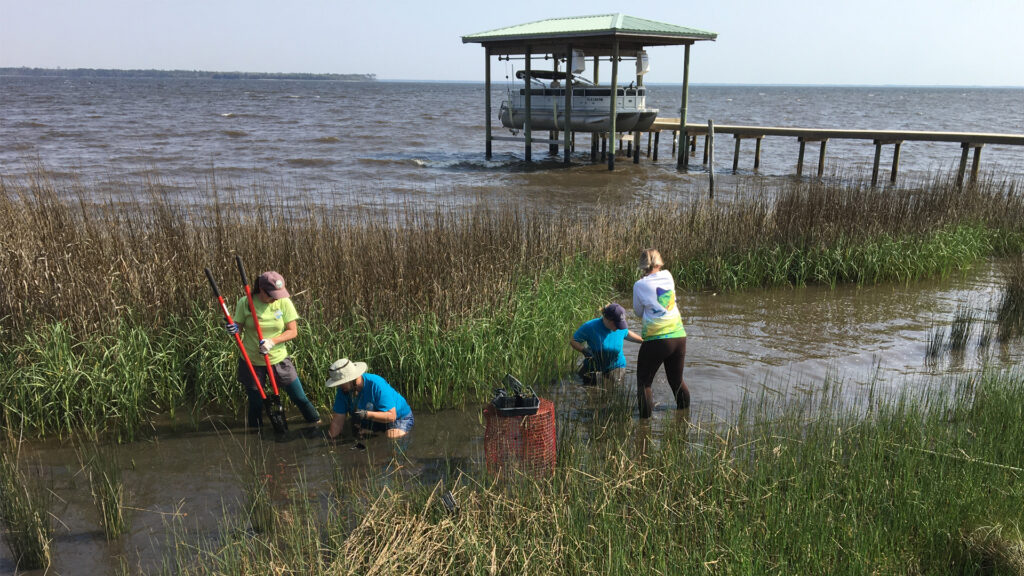By Kelli Doré, River Kidz
We often joke that it’s hard to find a hill in Florida, but our low-lying lands leave us especially vulnerable to the consequences of climate change. Our beautiful shorelines and diverse ecosystems are increasingly threatened by climate change impacts such as rising sea levels, intensifying storms and eroding coastlines.
Rising sea levels encroach on coastal communities, damaging infrastructure and causing saltwater intrusion into the aquifer that provides our drinking water. Hurricanes such as Dorian, Ian and Idalia showed our vulnerability to extreme weather and the need for innovative methods to protect our coasts. Traditional methods, such as concrete bulkheads and seawalls, may offer short-term relief but often exacerbate the problems they aim to solve by destroying critical habitats, eroding beaches and harming water quality.

Living shorelines provide an affordable and sustainable alternative. They are made up of a combination of natural elements such as native vegetation and oyster reefs that work to stabilize shorelines, protect against erosion and provide habitat for wildlife. They also adapt to changing conditions, growing and evolving as sea levels rise. Living shorelines offer variability and flexibility in mitigating the challenges facing Florida’s coastline.
This October, I attended a two-day workshop on living shorelines taught by staff from Florida Sea Grant, the Florida Department of Environmental Protection, the U.S. Army Corps of Engineers and the South Florida Water Management District. It was an informative workshop for participants from all backgrounds to explore the importance of living shorelines as a way to safeguard our coastal areas while also promoting biodiversity and sustainable development.
We’ve seen the impacts of overdevelopment and hardscaping on the Treasure Coast with seagrass die-off, water quality issues due to poor drainage and runoff, shoreline erosion, flooding, etc. I can’t count how many times I’ve heard folks share stories about how abundant the fishing used to be in the Indian River Lagoon, but without seagrass, we have no fish nurseries, and with no fish nurseries, there are no fish. Living shorelines can incorporate seagrasses, mangroves and other native plants to protect water quality and provide breeding grounds and shelter for marine life.
Living shorelines also benefit the upland side of our coastal environments. They can slow down runoff, capture marine debris and act as a natural filtration system, contributing to our shorelines’ overall health and resilience while providing benefits to both the environment and the communities that rely on them.
They also absorb wave energy and reduce erosion. In contrast, traditional hard infrastructure such as seawalls and bulkheads often reflect wave energy back into the water, increasing erosion while degrading habitat and water quality.

In addition, living shorelines contribute to carbon sequestration. Mangroves, for example, store vast amounts of carbon in their root systems, reducing excess carbon dioxide in our atmosphere and mitigating the impacts of climate change. This not only benefits Florida but also plays a part in the global effort to combat climate change.
Living shorelines benefit our local economy by preserving coastal property values, providing recreational opportunities and supporting industries that depend on our shorelines. They attract tourists with their natural beauty and encourage responsible development practices, which are increasingly important for coastal resilience as Florida’s population continues to grow.
While there are compelling reasons to embrace living shorelines, there are challenges to their widespread adoption. Regulatory barriers, limited public awareness and the upfront costs can deter their implementation. To overcome these hurdles, the government, private sector and environmental groups must collaborate on educational campaigns and create financial incentives for property owners to prioritize the transition to living shorelines.
By supporting and investing in living shoreline projects, we can pave the way for a more resilient and sustainable Florida.
Kelli Doré is the co-lead of River Kidz, a subcommittee of the Rivers Coalition, as well as the operations director for the Everglades Law Center and a graduate student in the University of Florida’s master of forest resources and conservation program. She lives in Jensen Beach.
If you are interested in submitting an opinion piece to The Invading Sea, email Editor Nathan Crabbe at nc*****@*au.edu. Sign up for The Invading Sea newsletter by visiting here.



